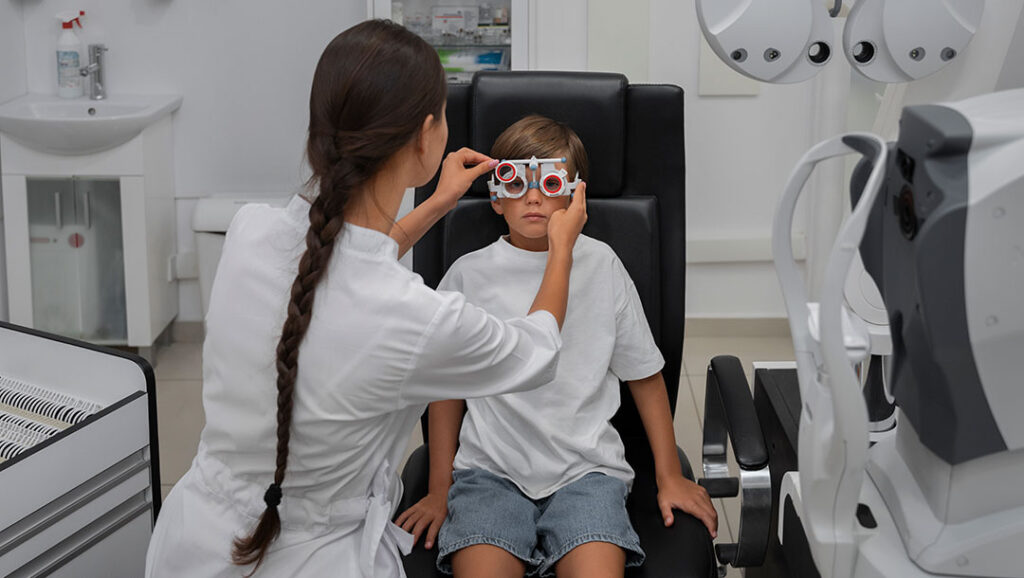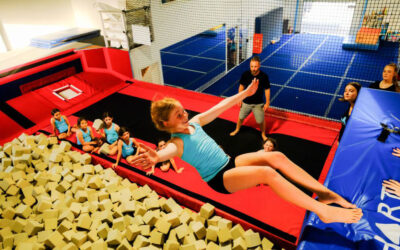When was the last time your little one had an eye test?
If you’re not sure, don’t stress—we get it. Parenting is a juggling act, and unless your child mentions vision problems, eye tests can easily slip down the to-do list.
But just like regular visits to the doctor or dentist, keeping an eye on their vision is essential for their development, learning, and overall well-being. That’s why routine check-ups with an optician are so important.
So, how often should kids have their eyes tested? And why does it matter?
In this post, we’ll break it all down—how often to book an appointment, key signs to watch for, and where to go when it’s time for a check-up.
Why is it important to get your kid’s eyes tested?
Children rely on their eyesight for almost everything—learning in school, playing with friends, participating in sports, and navigating the world around them.
But when vision problems go undetected, they can impact a child’s confidence, academic performance, and even their ability to socialise and enjoy everyday activities. Conditions like myopia (short-sightedness), lazy eye, and astigmatism are surprisingly common, yet many children don’t even realise they have them.
That’s why regular eye tests are so important. Booking an eye test with 1001 Optometry or another trusted optician helps catch issues early, ensuring kids get the corrective treatment they need before vision problems start affecting their daily lives.

Boy getting an eye test.
How often should kids get their eyes tested?
Now that you know why regular eye tests are important, let’s talk about how often your child should have them. In Australia, recommendations vary by age:
Ages 0 – 3
At birth, a baby’s eyes are checked as part of their general health assessment. However, optometrists recommend scheduling their first comprehensive eye test around six months old. This early check-up helps establish a baseline and detect any potential vision issues.
Ages 3 – 5
Just before starting Prep is another key time for an eye test. This check-up ensures your child is ready for learning, play, and social activities. Since their vision is still developing, an optometrist will assess for conditions like strabismus (crossed eyes) and amblyopia (lazy eye). Detecting these early makes treatment much easier and more effective.
Queensland Health offers a free vision screening during Prep for all children. You can find out more about that here.
Ages 6 – 12
For school-aged children, an eye test every two years is recommended unless advised otherwise. However, if your child frequently complains of headaches, struggles with reading, has poor hand-eye coordination, or squints often, it’s best to book an appointment sooner. These could be signs of an undiagnosed vision issue.
Ages 13 – 17
As teenagers grow, so does their vision — often changing rapidly. Regular eye tests every two years remain important, especially considering the increased screen time for both school and leisure. With conditions like myopia and digital eye strain becoming more common in teens, staying on top of their eye health ensures they can see clearly and comfortably as they navigate these crucial years.
What are the signs your child might need an eye test?
We mentioned this earlier, but it’s worth repeating—while regular eye tests every two years are recommended, don’t wait that long if you suspect your child is having vision problems. Book an appointment as soon as concerns arise.
Here are some things you should look out for that might indicate your child is struggling with their vision.
- Frequent eye rubbing or headaches
- Squinting to see the TV or whiteboard
- Trouble concentrating in class
- Poor hand-eye coordination or clumsiness
- Closing one eye to read or watch something
- Holding books or tablets too close to their face
- Avoiding reading or homework
If you recognise any of these behaviours or symptoms, don’t wait for their next scheduled visit; get them into the optician as soon as you can.
How to better protect your child’s eyesight
Between eye check-ups, there are several ways to help maintain and even improve your child’s eyesight.
One of the most important is managing screen time. While it can be tricky — especially if they need devices for schoolwork — encouraging regular breaks is key. Balancing screen use with outdoor time is also beneficial, not just for their overall well-being but to help reduce the risk of myopia.
Lighting matters too. Ensure your home has plenty of natural light, as poor lighting can contribute to eye strain and fatigue.
And remember those childhood reminders about carrots being good for your eyes? There’s truth to it! Carrots are rich in beta-carotene, which the body converts into vitamin A. A diet high in vitamins A and C, plus omega-3 fatty acids, supports eye health, so be sure they’re getting plenty of nutrient-rich foods.
Finally, quality sleep is just as important. Aim for 7 to 9 hours each night to give their eyes the rest they need.


